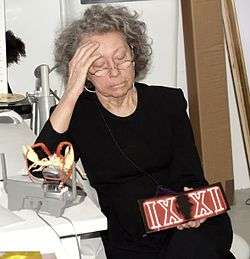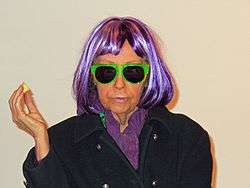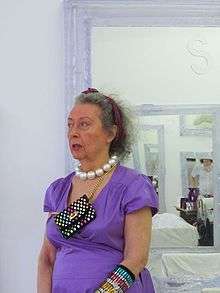Isabelle Collin Dufresne
Isabelle Collin Dufresne (stage name Ultra Violet; 6 September 1935 – 14 June 2014) was a French-American[1][2] artist, author, and both a colleague of Andy Warhol and one of the pop artist's so-called superstars. Earlier in her career, she worked for and studied with surrealist artist Salvador Dalí. Dufresne lived and worked in New York City, and also had a studio in Nice, France.
Isabelle Collin Dufresne | |
|---|---|
 Ultra Violet in her New York City studio, 2008 | |
| Born | 6 September 1935 La Tronche, Grenoble, France |
| Died | 14 June 2014 (aged 78) Beth Israel Medical Center, New York City, New York, U.S. |
| Other names | Ultra Violet |
| Occupation | Actress, writer, artist |
Early life
Isabelle Collin Dufresne was brought up in a strict religious upper-middle-class family,[3] but she rebelled at an early age.[2] She was instructed at a Catholic school, and then a reform school.[4] In 1953, she received a BA in Art at Le Sacré Cœur in Grenoble, France. She soon left France to live with an older sister in New York City.[2]
Salvador Dalí and New York City
In 1954, after a meeting with Salvador Dalí, she became his "muse", pupil, studio assistant, and lover[2][5] in both Port Lligat, Spain, and in New York City. Later, she would recall, "I realized that I was 'surreal', which I never knew until I met Dalí".[6] In the 1960s, Dufresne began to follow the progressive American Pop Art scene including Jasper Johns, Robert Rauschenberg and James Rosenquist.
Warhol and "The Factory"

In 1963, Dalí introduced Dufresne to Andy Warhol, and soon she moved into the orbit of his unorthodox studio, "The Factory".[6] In 1964 she selected the stage name "Ultra Violet" at Warhol's suggestion, because it was her preferred fashion — her hair color at the time was often violet or lilac.[5] She became one of many "superstars" in Warhol's Factory, and played multiple roles in over a dozen films between 1965 and 1974.
In 1967 Ultra Violet played a part (with, among others, Taylor Mead) in the surrealistic play Desire Caught by the Tail by Pablo Picasso when it was set for the first time in France at a festival in Saint-Tropez. She would eventually appear in more than 20 films, not counting numerous documentaries made at the Factory.[2]
At various points in her career she would meet numerous celebrities, including John Graham, John Chamberlain, Edward Ruscha, Rudolf Nureyev, Miloš Forman, Howard Hughes, Richard Nixon, Aristotle Onassis, Maria Callas, Marcel Duchamp, Man Ray, Marc Chagall, Bob Dylan, John Lennon and Yoko Ono.[3][7] In later reminiscences, she would name Ruscha, Nureyev, and Forman among her past lovers.[2][5]
In 1969, she was "dethroned" as Warhol's primary muse by Viva, a more recent discovery.[7]
Although a full participant in activities at the Factory, she generally avoided the heavy drug usage prevalent at the time, saying that her body reacted badly to drugs. She had tried smoking as a rebellious teen, had gotten very sick as a result, and resolved to abstain from drug usage. She would later observe, "If I had lived like all those young people, I would be dead today".[7]
In the 1980s, she gradually drifted away from the Factory scene, taking a lower profile and working independently on her own art. In her autobiography, published the year after Warhol's unexpected demise in 1987, she chronicled the activities of many Warhol superstars, including several untimely deaths during and after the Factory years.[8]
Later career

In 1988, Ultra Violet published her autobiography, Famous for 15 Minutes: My Years with Andy Warhol. This autobiography was edited extensively and partially translated from French to English by her New York penthouse roommate Natalie Durkee. After a review of the book in the New York Times,[3] it was published worldwide, eventually in 17 languages. After a book tour, she returned to France; in 1990 she opened a studio in Nice and wrote another book detailing her own ideas about art, L'Ultratique. She lived and worked as an artist in New York City,[6] and also maintained a studio in Nice for the rest of her life.[9]
In 2000, she was featured in Message to Andy Warhol, a "concept art documentary" by Laurent Foissac.
On April 10, 2005 she joined a panel discussion "Reminiscences of Dalí: A Conversation with Friends of the Artist" as part of a symposium "The Dalí Renaissance" for a major retrospective show at the Philadelphia Museum of Art.[10] Her conversation with another former Dalí protégée, French singer/actress Amanda Lear, is recorded in the 236-page exhibition catalog, The Dalí Renaissance: New Perspectives on His Life and Art after 1940.[11]
In 2006, she had a solo show at Stefan Stux Gallery in Chelsea, Manhattan.[12][13] In 2007 she gave a retrospective lecture at the New York Institute of Technology.
In 2010, filmmaker David Henry Gerson released Ultra Violet for Sixteen Minutes, a short documentary showing her perspectives on fame, art, religion, and her current artistic practice.[14]
In 2011, she was featured in a brief article about the surviving former Warhol "Superstars".[15] Regarding her famous past and her artwork today, she has said, "People always want to know about the past, but I'm much more interested in tomorrow".[16] In 2011, she exhibited a series of artworks as her personal memorial of the September 11 attacks, which were displayed in the exhibit Memorial IX XI at Queensborough Community College.[17]
In a 2012 interview, she said, "I'm a New Yorker, I'm an American, and I'm an artist. Because of those three things, I had to do something about 9/11, and the question was what to do, which is not simple".[1]
On August 12, 2014 independent record label Refinersfire released a posthumous limited edition 2-disc collection of original music and private conversations of Ultra Violet and Andy Warhol. The music was recorded in the late 1960s and early 1970s, and features cover performances of "La vie en Rose", "Mojo Queen", and the original songs "Famous for Fifteen Minutes" and "Moon Rock". Ultra Violet also had recorded private telephone conversations between herself and Andy Warhol, which feature topics such as police harassment, their films, the business of art, the RFK assassination, and Valerie Solanas and her attempt on Warhol's life.[18]
She gave her last TV-interview for the German documentary Wie ich lernte, die Zahlen zu lieben/How I Learned to Love the Numbers about OCD by Oliver Sechting & Max Taubert.
Her last exhibition in New York, Ultra Violet: The Studio Recreated, closed three weeks before her death. It included paintings, sculptures, photographs, films, and neon art.[2]
Personal life
In 1973, a near-death experience and a bout with depression launched Ultra Violet on a spiritual quest, culminating in her baptism in 1981. For the rest of her life, she was a practicing member of The Church of Jesus Christ of Latter-day Saints.[2][7][9]
Dufresne died on 14 June 2014 in New York City at the age of 78, from cancer.[5][19] She had never married. Dufresne was survived by two sisters.[5] She is buried in Saint-Égrève near Grenoble.[2]
Books
- Famous for 15 Minutes: My Years with Andy Warhol. Photography by Sam Falk. San Diego: Harcourt Brace Jovanovich. 1988. ISBN 9780151302017.
- Andy Warhol: Superstar (in German). Bergisch Gladbach, DE: Bastei Lübbe. 1991. ISBN 9783404612055.
- L'Ultratique (in French). Lodève, FR: Imprimerie des Beaux-Arts. 1991. ISBN 9782908811162.
Filmography
- Blackout (1994) .... Arlette
- An Unmarried Woman (1978) .... Lady MacBeth
- Curse of the Headless Horseman (1974) .... Contessa Isabel du Fren
- Bad Charleston Charlie (1973)
- Savages (1972) .... Iliona, a Decadent
- Believe in Me (1971) .... Patient
- The Telephone Book (1971) .... Whip Woman
- Simon, King of the Witches (1971) .... Sarah
- Taking Off (1971) .... SPFC Member
- Dinah East (1970) .... Daniela
- Brand X (1970) .... Singer
- The Phynx (1970) .... Felice
- Cleopatra (1970)
- Maidstone (1970) .... Herself
- Midnight Cowboy (1969) .... The Party
- The Secret Life of Hernando Cortez (1969) .... Daughter of Montezuma
- **** (The 24 Hour Movie) (1967)
- I, a Man (1967)
- The Life of Juanita Castro (1965)
- Cinématon #1084 (1988) by Gérard Courant ... Herself
- Lire #27 (1988) by Gérard Courant ... Herself
- Portrait de groupe #92 : Avec Ultra-Violet à Paris by Gérard Courant ... Herself
- La Collection secrète de Salvador Dalí (1992) by Otto Kelmer ... Herself [20]
- Message to Andy Warhol (2000) by Laurent Foissac ... Herself
- Wie ich lernte, die Zahlen zu lieben (2014) by Oliver Sechting & Max Taubert ... Herself
See also
References
- Sturrock, Staci (January 19, 2012). "Andy & me: Ultra Violet, an Andy Warhol 'superstar,' visits ArtPalmBeach this weekend". PB Pulse. The Palm Beach Post. Archived from the original on 16 June 2014. Retrieved 25 May 2012.
- Jardonnet, Emmanuelle (16 June 2014). "Ultra Violet, " superstar " warholienne, est morte". Le Monde (in French). Retrieved 2019-03-22.
- Glueck, Grace (November 20, 1988). "We threw Andy out of our orgy". The New York Times. Retrieved 24 May 2012.
- Watson, Steven (2003). Factory Made: Warhol and the Sixties. New York: Pantheon. p. 204. ISBN 0679423729.
- Gates, Anita (2014-06-15). "Ultra Violet, Warhol superstar, dies at 78". The New York Times.
- Scrudato, Ken (October 12, 2011). "Ultra Violet on Fame, the Factory, & Leaving Dali for Warhol". BlackBook. BlackBook. Archived from the original on January 18, 2013. Retrieved 24 May 2012.
- Gondouin-Haustein, Vanessa (August 25, 2008). "De Dali aux Mormons, en passant par Warhol". French Morning New York (in French). French Morning. Archived from the original on January 23, 2013. Retrieved 25 May 2012.
- Hubbard, Kim; Kahn, Toby (November 7, 1988). "Once Andy Warhol's Ultra Violet, Isabelle Dufresne writes the book on being famous for 15 minutes". People. Retrieved 24 May 2012.
- "Nice Ultra Violet, le quart d'heure de célébrité d'une Niçoise chez Warhol". nicematin.com (in French). Nice-Matin. August 15, 2009. Retrieved 11 June 2013.
- "The Dalí Renaissance: An international symposium" (PDF) (Symposium announcement). Philadelphia Museum of Art. April 10–11, 2005. Archived from the original (PDF) on 14 November 2012. Retrieved 24 May 2012.
- Taylor, Michael R., ed. (2008). The Dalí Renaissance: New Perspectives on his Life and Art after 1940: An International Symposium. New Haven, CT: Yale University Press for The Philadelphia Museum of Art. ISBN 9780300136470.
- Cone, Michèle C. (2006). "Who can forget Ultraviolet?". artnet Magazine. Artnet Worldwide. Retrieved 24 May 2012.
- Glueck, Grace (February 17, 2006). "Art in Review; Ultra Violet". The New York Times. Retrieved 24 May 2012.
- "A Q&A with David Henry Gerson, filmmaker 'Ultra Violet for Sixteen Minutes' Part I". theartdossier.com. The Art Dossier. June 1, 2011. Archived from the original on 18 November 2014. Retrieved 11 June 2013.
- Berman, Judy (April 22, 2011). "Andy Warhol's superstars: Where are they now?". Flavorwire. Flavorpill Productions. Retrieved 11 June 2013.
- McElroy, Steven (July 1, 2011). "A 'Factory' worker glances back". The New York Times. Retrieved 24 May 2012.
- Carlson, Jen (August 22, 2011). "Salvador Dalí muse, Ultra Violet, creates 9/11 sculpture" (blog). Gothamist. Archived from the original on July 11, 2014.
- "Ultra Violet | Self Portrait". Ultravioletselfportrait.com. Retrieved 2018-03-25.
- Larsen, Kent (June 14, 2014). "Her 15 minutes at an end: Ultra Violet dead at 78". Times & Seasons (blog). Retrieved 15 June 2014.
- La Collection secrète de Salvador Dalí. on the Website of IMDb. Retrieved 25 March 2018.
External links
| Wikimedia Commons has media related to Isabelle Collin Dufresne (Ultra Violet). |